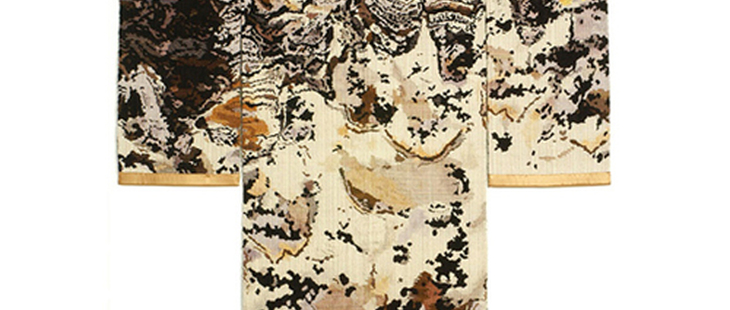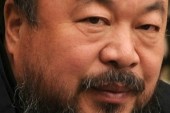
Don’t expect to find Amish quilts and sunflower-themed tapestry at Hard Twist, the Gladstone Hotel’s 6th annual textile and fibre-based art show running from November 25th to January 29th. Over the next few days, we’ll be profiling a few of the participating Hard Twist artists.
 (Striation – 60" x 52", weaving/cotton, wool, silk, rayon; 2005)
(Striation – 60" x 52", weaving/cotton, wool, silk, rayon; 2005)
Finding inspiration from frequent trips to the deserts of Southern California, textile Artist George-Ann Bowers creates nature inspired weavings. Although primarily self taught, she has studied at California College of Arts in Oakland and the Pacific Basin School of Textile Arts in Berkeley, California. In 2005, her kimono piece “Striation” (pictured above) was selected for exhibition in the prestigious Fifth International Textile Art Triennial in Tournai, Belgium.
Describe the work you’re exhibiting.
The piece I’m exhibiting is a handwoven wall hanging in the shape of a Japanese kimono (not wearable). The imagery in the piece is from a section of aspen tree bark from a macro perspective, with a focus on the striated patterns and colors of a particularly interesting section of tree trunk, hence the title “Striation”.
 (Canyon Kimono – 59" x 58"; weaving/cotton, wool, rayon, silk; 2006)
(Canyon Kimono – 59" x 58"; weaving/cotton, wool, rayon, silk; 2006)
Any reasons as to why you choose textiles and/or fibres as a medium?
I became interested in textiles and weaving in particular during the late 1960s and early ’70s, partly through shared experiences and interests with a college roommate who studied textile art, and partly because of the surge of interest in textile art at that time, here in the San Francisco Bay Area as well as internationally. The Bay Area had several flourishing retail outlets for fibre materials, many colleges/universities offered full textile art programs, and the city of Berkeley was blessed with the presence of two excellent independent private textile schools, Pacific Basin School of Textile Arts and Fiberworks Center for the Textile Arts. While taking classes at both of these establishments, I became hooked on textiles in general, and weaving in particular.
The materials themselves are a major draw for me. Weaving is a very tactile process, and I love the feel of yarns and their gorgeous colors. I enjoy the building of a design in increments, mixing colors thread by thread. With my weaving technique, construction of artwork proceeds very slowly, and the process becomes almost meditative or hypnotic.
 (Ohlone Housecoat – 36" x 33"; weaving/cotton, wool, rayon, silk, stuffed; 2009)
(Ohlone Housecoat – 36" x 33"; weaving/cotton, wool, rayon, silk, stuffed; 2009)
Describe the process for creating your work as part of Hard Twist.
The weaving technique which I use regularly is based on double-weave pickup, traditional historically in Scandinavian countries, pre-Columbian Peru, and early 19th Century America. In double weave two sets of warp (vertical) yarns and two sets of weft (horizontal) yarns are interconnected to form a two-layered cloth. “Picking up” and moving threads between the layers allows complex patterns and surface textures to be created. As was the case for “Striation”, I frequently work with three layers at once to expand the color options within an individual piece (each warp layer consists of different colors), and often paint sections of the warp as I’m weaving for further color variation.
I usually take my designs from my photos of natural subjects, and create a full-sized line drawing on graph paper of the composition, which I tape to the loom in front of me and refer to constantly as I work. I use a long flat pickup stick to lift threads from the lower layers to show on the surface while I weave the top layer, and reverse the process to weave the lower layers.
Textile-based art is typically very time consuming. How long did this installation take you?
“Striation”, the work I am exhibiting, was woven in approximately 8 months. The rate of weaving depends on the width of a specific piece, but if I manage to weave at an average of 2 inches per hour, I feel I’m really speeding along. More typical with my complex designs and multiple colors is a rate of about 1/2 inch per hour.
 (Annie Creek – 30" x 68" x 8"; weaving/cotton, wool, rayon, silk, wire armature; 2002)
(Annie Creek – 30" x 68" x 8"; weaving/cotton, wool, rayon, silk, wire armature; 2002)
What is your favorite textile-based possession? Why?
My large collection of yarn in all colors and fibres is probably my favorite “possession”. In designing a new piece, I love pulling out a selection of yarn skeins, piling them on the table and moving them around to work out which colors to use. I keep the yarn pile on the table while working on the weaving, adding and subtracting yarns as I refine my color selection during the project. A trip to a yarn store to find a particular color of yarn is a dangerous undertaking, as I invariable come home with a larger-than-intended addition to my stash.
Name one Canadian contemporary art show or artist that really made an impact on you this year.
I am quite enthralled by the beautiful work of Lesley Richmond. Her “Tree Series” is featured in the current issue of Surface Design Magazine (Fall 2011) which spotlights Canadian textile artists.
What’s next?
Next is to finish the current kimono project on the loom. Following that, or maybe concurrently, I will weave a smaller piece based on my observations of nature as artist in residence last September at Acadia National Park in Maine, which piece will then become part of the US National Parks’ art collection. I have several other projects in mind for the near future, involving the exploration of woven and manipulated 3-D shapes, all utilizing nature-based imagery.
Previously profiled Hard Twist artist: Kate Busby














